-
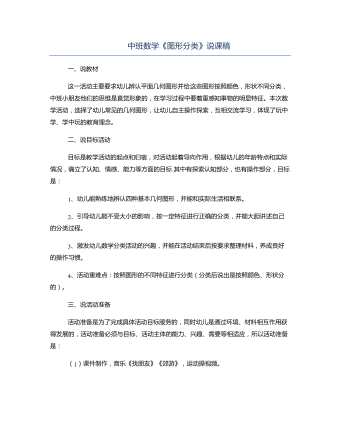
中班数学《图形分类》说课稿
1、创设情境、激发幼儿参与活动的兴趣兴趣是最好的老师。通过律动运动操引起幼儿上课的兴趣,吸引他们的注意力,激发他们参与活动的兴趣。引导学生回忆已经学过的图形,借机引出课题,交代学习目标。2、合作交流,探究新知(1)梳理思路,展示过程。教师用电子白板演示分类的过程,加深学生对图形分类的认识。(2)幼儿分组尝试分类提出分类问题之后,让幼儿先思考一下如何分类,在独立思考的基础上再让幼儿借助学具分小组动手分一分,说一说。(3)运用拓展,课外延伸出示拼图,启发幼儿用几何图形自由快乐拼图。引导他们思考问题,寻求解决问题的办法,相互交流帮助,分享探索的过程和结果。从而得出结论--用几个不同形状的图形能拼出一个新的图形来。幼儿在游戏过程中反复感受、反复体验以突破难点。同时也培养孩子初步的合作意识和能力。
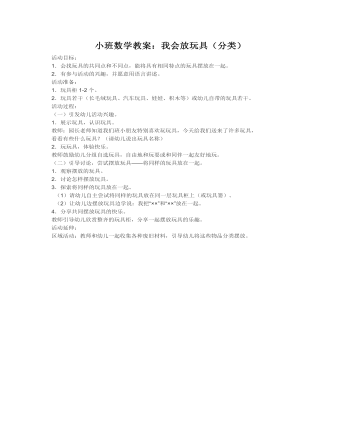
小班数学教案:我会放玩具(分类)
2.有参与活动的兴趣,并愿意用语言讲述。 活动准备: 1.玩具柜1-2个。 2.玩具若干(长毛绒玩具、汽车玩具、娃娃、积木等)或幼儿自带的玩具若干。 活动过程: (一)引发幼儿活动兴趣。 1.展示玩具,认识玩具。 教师:园长老师知道我们班小朋友特别喜欢玩玩具,今天给我们送来了许多玩具, 看看有些什么玩具?(请幼儿说出玩具名称) 2.玩玩具,体验快乐。 教师鼓励幼儿分组自选玩具,自由地和玩耍或和同伴一起友好地玩。
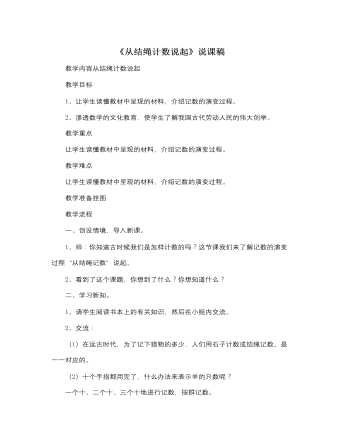
北师大版小学数学四年级上册《从结绳计数说起》说课稿
教学内容从结绳计数说起教学目标1、让学生读懂教材中呈现的材料,介绍记数的演变过程。2、渗透数学的文化教育,使学生了解我国古代劳动人民的伟大创举。教学重点让学生读懂教材中呈现的材料,介绍记数的演变过程。教学难点让学生读懂教材中呈现的材料,介绍记数的演变过程。教学准备挂图教学流程一、创设情境,导入新课。1、师:你知道古时候我们是怎样计数的吗?这节课我们来了解记数的演变过程“从结绳记数”说起。2、看到了这个课题,你想到了什么?你想知道什么?二、学习新知。1、请学生阅读书本上的有关知识,然后在小组内交流。2、交流:(1)在远古时代,为了记下猎物的多少,人们用石子计数或结绳记数。是一一对应的。
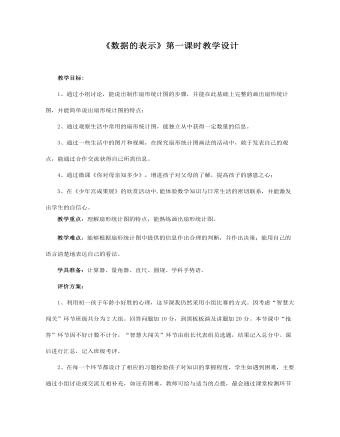
数据的收集与整理 3 数据的表示教案教学设计
创设情境,导入新课:你对母亲知多少师问1:我们5月份刚过了一个重要的节日,你知道是什么吗?----母亲节。师问2:那你知道妈妈的生日吗?(举手示意),每个妈妈都知道自己孩子的生日,请不知道的同学回家了解一下,多关心一下自己的父母。师问3:那你知道妈妈最爱吃的菜吗?你可以选择知道、不知道或者是没有爱吃的(拖动白板上相对应的表情符号)。请大家用不同的手势表示出来。我找3名同学统计各组的数据,写在黑板上(随机找3名学生数人数)。下面我来随机采访一下:你妈妈最喜欢吃的菜是什么?(教师随机采访,结合营养搭配和感恩教育)
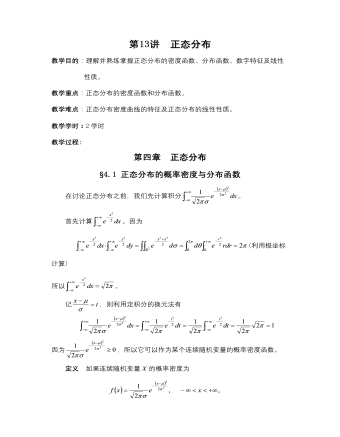
【高教版】中职数学拓展模块:3.5《正态分布》教学设计
教学目的:理解并熟练掌握正态分布的密度函数、分布函数、数字特征及线性性质。教学重点:正态分布的密度函数和分布函数。教学难点:正态分布密度曲线的特征及正态分布的线性性质。教学学时:2学时教学过程:第四章 正态分布§4.1 正态分布的概率密度与分布函数在讨论正态分布之前,我们先计算积分。首先计算。因为(利用极坐标计算)所以。记,则利用定积分的换元法有因为,所以它可以作为某个连续随机变量的概率密度函数。定义 如果连续随机变量的概率密度为则称随机变量服从正态分布,记作,其中是正态分布的参数。正态分布也称为高斯(Gauss)分布。

新人教版高中英语必修3Unit 1 Festivals and Celebrations教学设计二
1. Ss look at the picture and scan the passage to understand the main idea while teacher is giving the following questions to inspire Ss to think.*Where are those people?*What are they doing?*Why are they so excited?2. Ss complete the passage with the appropriate -ing form. Then discuss and check the answers with class.Answers: boring, interesting, taking, exciting, amazing3. The teacher raises questions for the students to discuss and encourages them to express their opinions.*Do you like La Tomatina? Why or why not?4. Each group representative reports the discussion result, the teacher gives feedback and the evaluation.Step 6 PracticeActivity 41. Ss complete the Ex 2 in Using structures.2. Check the answers after finishing the exercises.①The dragon boat races are the most exciting part of the Dragon Boat Festival.② The children were excited to go Easter egg hunting.③What an amazing performance! This is the best music festival I have ever been to.④We were amazed by her funny-looking hat.⑤His inspiring speech at the conference won the admiration/ favour of the audience.⑥This is a challenging game to test your memory and observation capabilities. 3. T asks Ss to finish Ex 3 and 4 in Using structures by themselves, then check the answers with class.Step 6 Homework1. Understand and master the functions and usage of the -ing form;2. Finish the other exercises in Using structures.1、通过本节内容学习,学生是否理解和掌握动词-ing形式作定语和表语的功能和意义;2、通过本节内容学习,学生能否在理解文段内容的基础上,根据上下文语境和表达逻辑,能正确运用动词-ing形式描述节日庆典。3、通过本节内容学习,学生是否归纳和积累用于表达情绪的相关词汇。

新人教版高中英语必修3Unit 1 Festivals and Celebrations教学设计一
本板块的活动主题是“谈论节日活动”(Talk about festival activities),主要是从贴近学生日常生活的角度来切入“节日”主题。学生会听到发生在三个国家不同节日场景下的简短对话,对话中的人们正在参与或将要亲历不同的庆祝活动。随着全球化的进程加速,国际交流日益频繁,无论是国人走出国门还是外国友人访问中国,都已成为司空见惯的事情。因此,该板块所选取的三个典型节日场景都是属于跨文化交际语境,不仅每组对话中的人物来自不同的文化背景,对话者的身份和关系也不尽相同。1. Master the new words related to holiday: the lantern, Carnival, costume, dress(sb)up, march, congratulation, congratulate, riddle, ceremony, samba, make - up, after all. 2. To understand the origin of major world festivals and the activities held to celebrate them and the significance of these activities;3. Improve listening comprehension and oral expression of the topic by listening and talking about traditional festivals around the world;4. Improve my understanding of the topic by watching pictures and videos about different traditional festivals around the world;5. Review the common assimilation phenomenon in English phonetics, can distinguish the assimilated phonemes in the natural language flow, and consciously use the assimilation skill in oral expression. Importance:1. Guide students to pay attention to the attitude of the speaker in the process of listening, and identify the relationship between the characters;2. Inspire students to use topic words to describe the festival activities based on their background knowledge. Difficulties:In the process of listening to the correct understanding of the speaker's attitude, accurately identify the relationship between the characters.

新人教版高中英语必修3Unit 1 Festivals and Celebrations教学设计三
*wide range of origins(= a great number of different origins, many kinds of origins)*It featured a parade and a great feast with music, dancing, and sports. (=A parade and a great feast with music, dancing, and sports were included as important parts of the Egyptian harvest festival.)*.. some traditions may fade away and others may be established.(= Some traditions may disappear gradually, while other new traditions may come into being.)Step 6 Practice(1) Listen and follow the tape.The teacher may remind the students to pay attention to the meaning and usage of the black words in the context, so as to prepare for the completion of the blanks in activity 5 and vocabulary exercises in the exercise book.(2) Students complete the text of activity 5 by themselves.The teacher needs to remind the students to fill in the blanks with the correct form of the vocabulary they have learned in the text.Students exchange their answers with their partners, and then teachers and students check their answers.(3)Finish the Ex in Activity 5 of students’ book.Step 7 Homework1. Read the text again, in-depth understanding of the text;2. Discuss the origin of festivals, the historical changes of related customs, the influence of commercial society on festivals and the connotation and essential meaning of festivals.3. Complete relevant exercises in the guide plan.1、通过本节内容学习,学生是否理解和掌握阅读文本中的新词汇的意义与用法;2、通过本节内容学习,学生能否结合文本特点快速而准确地找到主题句;3、通过本节内容学习,学生能否理清论说文的语篇结构和文本逻辑,了解节日风俗发展与变迁,感悟节日的内涵与意义。
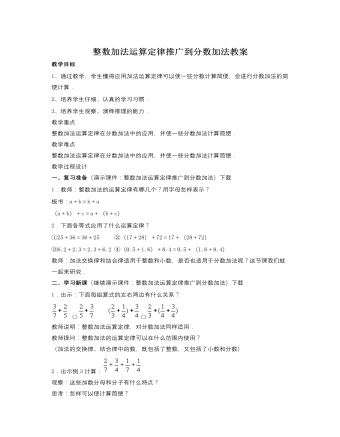
人教版新课标小学数学五年级下册整数加法运算定律推广到分数加法教案
教学目标1、通过教学,学生懂得应用加法运算定律可以使一些分数计算简便,会进行分数加法的简便计算.2、培养学生仔细、认真的学习习惯.3、培养学生观察、演绎推理的能力.教学重点整数加法运算定律在分数加法中的应用,并使一些分数加法计算简便.教学难点整数加法运算定律在分数加法中的应用,并使一些分数加法计算简便.教学过程设计一、复习准备(演示课件:整数加法运算定律推广到分数加法)下载1.教师:整数加法的运算定律有哪几个?用字母怎样表示?板书:a+b=b+a(a+b)+c=a+(b+c)2.下面各等式应用了什么运算定律?①25+36=36+25 ②(17+28)+72=17+(28+72)③6.2+2.3=2.3+6.2 ④(0.5+1.6)+8.4=0.5+(1.6+8.4)教师:加法交换律和结合律适用于整数和小数,是否也适用于分数加法呢?这节课我们就一起来研究.二、学习新课(继续演示课件:整数加法运算定律推广到分数加法)下载1.出示:下面每组算式的左右两边有什么关系?
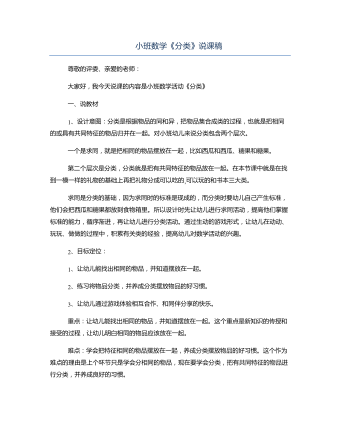
小班数学《分类》说课稿
1、设计意图:分类是根据物品的同和异,把物品集合成类的过程,也就是把相同的或具有共同特征的物品归并在一起。对小班幼儿来说分类包含两个层次。一个是求同,就是把相同的物品摆放在一起,比如西瓜和西瓜、糖果和糖果。第二个层次是分类,分类就是把有共同特征的物品放在一起。在本节课中就是在找到一模一样的礼物的基础上再把礼物分成可以吃的,可以玩的和书本三大类。求同是分类的基础,因为求同时的标准是现成的,而分类时要幼儿自己产生标准,他们会把西瓜和糖果都放到食物箱里。所以设计时先让幼儿进行求同活动,提高他们掌握标准的能力,循序渐进,再让幼儿进行分类活动。通过生动的游戏形式,让幼儿在动动、玩玩、做做的过程中,积累有关类的经验,提高幼儿对数学活动的兴趣。2、目标定位:1、让幼儿能找出相同的物品,并知道摆放在一起。2、练习将物品分类,并养成分类摆放物品的好习惯。3、让幼儿通过游戏体验相互合作、和同伴分享的快乐。
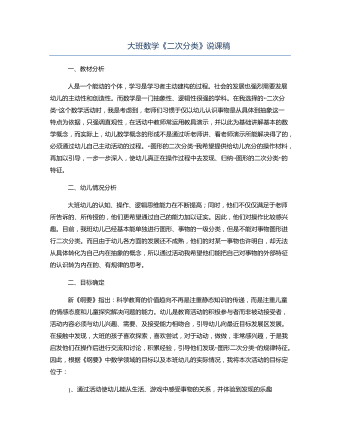
大班数学《二次分类》说课稿
人是一个能动的个体,学习是学习者主动建构的过程。社会的发展也强烈需要发展幼儿的主动性和创造性。而数学是一门抽象性、逻辑性很强的学科。在我选择的“二次分类”这个数学活动时,我是考虑到,老师们习惯于仅以幼儿认识事物是从具体到抽象这一特点为依据,只强调直观性,在活动中教师常运用教具演示,并以此为基础讲解基本的数学概念,而实际上,幼儿数学概念的形成不是通过听老师讲、看老师演示所能解决得了的,必须通过幼儿自己主动活动的过程。“图形的二次分类”我希望提供给幼儿充分的操作材料,再加以引导,一步一步深入,使幼儿真正在操作过程中去发现、归纳“图形的二次分类”的特征。
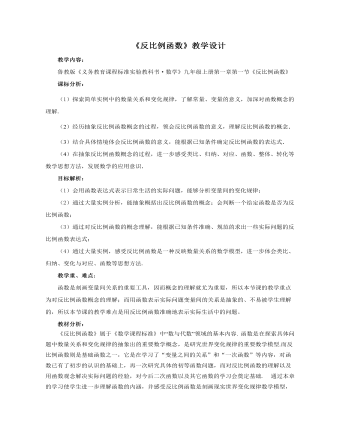
反比例函数教案教学设计
本节的内容主要是反比例函数的概念教学.反比例函数概念的建立,不能从形式上进行简单的抽象与概括,而是对这些实例从不同角度抽象出本质属性后,再进行概括。教材设计的基本思路是从现实生活中大量的反比例关系中抽象出反比例函数概念,让学生进一步感受函数是反映现实世界中变量关系的一种有效数学模型,逐步从对具体反比例函数的感性认识上升到对抽象的反比例函数概念的理性认识. 同时本节的学习内容,直接关系到本章后续内容的学习,也是继续学习其它各类函数的基础,其中蕴涵的类比、归纳、对应和函数的数学思想方法,对学生今后研究问题、解决问题以及终身的发展都是非常有益的.基于以上分析,本节教学设计是建立在一个个数学活动的基础上,经过对情境理解、本质抽象的积累而形成的.让学生对一类问题情境中两个变量间的关系,在充分经历写表达式,计算函数值和观察函数值随自变量变化规律的过程中,逐步概括形成反比例函数的概念.针对教学实际,我选取了贴学生现实的,有价值的实例“文具店里买学习用品”和“剪面积为定值的长方形纸片”等作为问题情境.
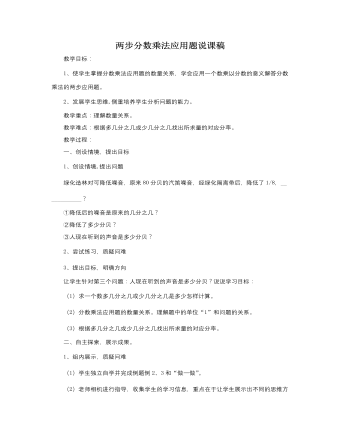
人教版新课标小学数学六年级上册两步分数乘法应用题说课稿
(三)看书质疑师:今天探索的问题与教科书第20-21页里例2-例3的内容相似,打开看看,书是怎么解答的?有疑问的可以提出来。生认真看书。生质疑。三、模拟练习,拓展应用师:请看学校调查表(课件出示),还有什么问题没有解决啊?(买折叠车和同学去秋游的人数)想解决吗?(想)师:提供这个信息能解决什么问题呢?生:买车的人数。师:你会直接口算吗?会的请你站起来告诉大家。生都站了起来了。师:这么都同学会啊,老师很为你们高兴,还是请代表说。生说。师:你们有意见吗?生:没有(好)师:谁能求出选择秋游的人数?生:不能啊,条件不充分师:那你能根据图意估计一下,然后补充一个条件,使我们能用今天的知识算出这些人数吗?
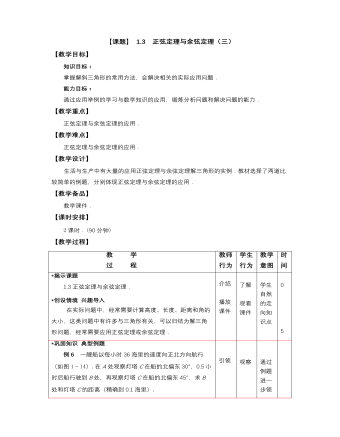
【高教版】中职数学拓展模块:1.3《正弦定理与余弦定理》教学设计
教 学 过 程教师 行为学生 行为教学 意图时间 *揭示课题 1.3正弦定理与余弦定理. *创设情境 兴趣导入 在实际问题中,经常需要计算高度、长度、距离和角的大小,这类问题中有许多与三角形有关,可以归结为解三角形问题,经常需要应用正弦定理或余弦定理. 介绍 播放 课件 了解 观看 课件 学生自然的走向知识点 0 5*巩固知识 典型例题 例6一艘船以每小时36海里的速度向正北方向航行(如图1-14).在A处观察灯塔C在船的北偏东30°,0.5小时后船行驶到B处,再观察灯塔C在船的北偏东45°,求B处和灯塔C的距离(精确到0.1海里). 解 因为∠NBC=45°,A=30°,所以C=15°, AB = 36×0.5 = 18 (海里). 由正弦定理得 答:B处离灯塔约为34.8海里. 例7 修筑道路需挖掘隧道,在山的两侧是隧道口A和B(图1-15),在平地上选择适合测量的点C,如果C=60°,AB = 350m,BC = 450m,试计算隧道AB的长度(精确到1m). 解 在△ABC中,由余弦定理知 =167500. 所以AB≈409m. 答:隧道AB的长度约为409m. 图1-15 引领 讲解 说明 引领 观察 思考 主动 求解 观察 通过 例题 进一 步领 会 注意 观察 学生 是否 理解 知识 点 40
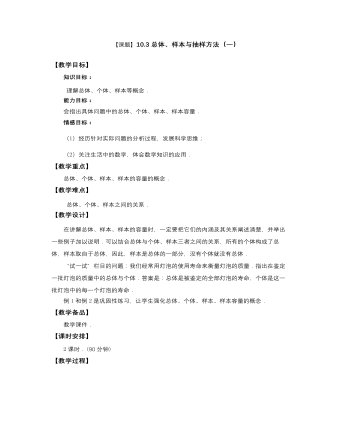
高教版中职数学基础模块下册:10.3《总体、样本与抽样方法》教学设计
教 学 过 程教师 行为学生 行为教学 意图时间 *揭示课题 10.3总体、样本与抽样方法(一) *创设情境 兴趣导入 【实验】 商店进了一批苹果,小王从中任意选取了10个苹果,编上号并称出质量.得到下面的数据(如表10-6所示): 苹果编号12345678910质量(kg)0.210.170.190.160.200.220.210.180.190.17 利用这些数据,就可以估计出这批苹果的平均质量及苹果的大小是否均匀. 介绍 质疑 讲解 说明 了解 思考 启发 学生思考 0 10*动脑思考 探索新知 【新知识】 在统计中,所研究对象的全体叫做总体,组成总体的每个对象叫做个体. 上面的实验中,这批苹果的质量是研究对象的总体,每个苹果的质量是研究的个体. 讲解 说明 引领 分析 理解 记忆 带领 学生 分析 20*巩固知识 典型例题 【知识巩固】 例1 研究某班学生上学期数学期末考试成绩,指出其中的总体与个体. 解 该班所有学生的数学期末考试成绩是总体,每一个学生的数学期末考试成绩是个体. 【试一试】 我们经常用灯泡的使用寿命来衡量灯炮的质量.指出在鉴定一批灯泡的质量中的总体与个体. 说明 强调 引领 观察 思考 主动 求解 通过例题进一步领会 35

新人教版高中英语必修3Unit 3 Diverse Cultures教学设计四
该板块的活动主题是“介绍一个有显著文化特征的地方”( Describe a place with distinctive cultural identity)。该板块通过介绍中国城继续聚焦中国文化。本单元主题图呈现的是旧金山中国城的典型景象, Reading and Thinking部分也提到中国城,为该板块作铺垫。介绍中国城的目的主要是体现中国文化与美国多元文化的关系,它是美国多元文化的重要组成部分。中国城也是海外华人的精神家园和传播中国文化的重要窗口,外国人在中国城能近距离体验中国文化。1. Read the text to understand the cultural characteristics of Chinatown in San Francisco and the relationship between Chinese culture and American multiculturalism;2. Through reading, learn to comb the main information of the article, understand the author's writing purpose and writing characteristics;3. Learn to give a comprehensive, accurate, and organized description of the city or town you live in;Learn to revise and evaluate your writing.Importance:1. Guide the students to read the introduction of Chinatown in San Francisco and grasp its writing characteristics;2. Guide students to introduce their city or town in a comprehensive, accurate and organized way;3. Learn to comb the main information of the article, understand the author's writing purpose, and master the core vocabulary.

新人教版高中英语必修3Unit 3 Diverse Cultures教学设计三
The price is the same as(the price was)before the war.价格与战前相同。(4)定语从句中的“关系代词+助动词be”可以省略。The ticket(that/which was)booked by his sister has been sent to him.他妹妹订的那张票已送到了他那里。Step 5 PracticeActivity 3(1) Guide students to complete the four activities in the Using Structures part of exercise book, in which activities 1 and 2 focus on ellipsis in dialogue answers, activity 3 focus on signs and headlines, two typical situations where ellipsis is used, and activity 4 focus on ellipsis in diary, an informal style.(2) Combine the examples in the above activities, ask students to summarize the omitted situations in groups, and make their own summary into a poster, and post it on the class wall after class to share with the class.(This step should give full play to the subjectivity of students, and teachers should encourage students to conclude different ellipsis phenomena according to their own understanding, they can conclude according to the different parts omitted in the sentence.)Step 6 Homework1. Understand and master the usages of ellipsis;2. Finish the other exercises in Using structures of Workbook.1、通过本节内容学习,学生是否理解和掌握省略的用法;2、通过本节内容学习,学生能否根据上下文语境或情景恢复句子中省略的成分,体会使用省略的效果;3、通过本节内容学习,学生能否独立完成练习册和导学案中的相关练习。

新人教版高中英语必修3Unit 3 Diverse Cultures教学设计二
(2)Consolidate key vocabulary.Ask the students to complete the exercises of activity 6 by themselves. Then ask them to check the answers with their partners.(The first language:Damage of the 1906 San Francisco earthquake and fire.A second language: Yunnan - one of the most diverse provinces in China).Step 5 Language points1. The teacher asks the students to read the text carefully, find out the more words and long and difficult sentences in the text and draw lines, understand the use of vocabulary, and analyze the structure of long and difficult sentences.2. The teacher explains and summarizes the usage of core vocabulary and asks the students to take notes.3. The teacher analyzes and explains the long and difficult sentences that the students don't understand, so that the students can understand them better.Step 6 Homework1. Read the text again, in-depth understanding of the text;2. Master the use of core vocabulary and understand the long and difficult sentences.3. Complete relevant exercises in the guide plan.1、通过本节内容学习,学生是否理解和掌握阅读文本中的新词汇的意义与用法;2、通过本节内容学习,学生能否结合文本特点了解文章的结构和作者的写作逻辑;3、通过本节内容学习,学生能否了解旧金山的城市风貌、文化特色,以及加利福尼亚州的历史,体会多元文化对美国的影响。

新人教版高中英语必修3Unit 3 Diverse Cultures教学设计一
Activity 81.Grasp the main idea of the listening.Listen to the tape and answer the following questions:Who are the two speakers in the listening? What is their relationship?What is the main idea of the first part of the listening? How about the second part?2.Complete the passage.Ask the students to quickly review the summaries of the two listening materials in activity 2. Then play the recording for the second time.Ask them to complete the passage and fill in the blanks.3.Play the recording again and ask the students to use the structure diagram to comb the information structure in the listening.(While listening, take notes. Capture key information quickly and accurately.)Step 8 Talking Activity 91.Focus on the listening text.Listen to the students and listen to the tape. Let them understand the attitudes of Wu Yue and Justin in the conversation.How does Wu Yue feel about Chinese minority cultures?What does Justin think of the Miao and Dong cultures?How do you know that?2.learn functional items that express concerns.Ask students to focus on the expressions listed in activity. 3.And try to analyze the meaning they convey, including praise (Super!).Agree (Exactly!)"(You're kidding.!)Tell me more about it. Tell me more about it.For example, "Yeah Sure." "Definitely!" "Certainly!" "No kidding!" "No wonder!" and so on.4.Ask the students to have conversations in small groups, acting as Jsim and his friends.Justin shares his travels in Guizhou with friends and his thoughts;Justin's friends should give appropriate feedback, express their interest in relevant information, and ask for information when necessary.In order to enrich the dialogue, teachers can expand and supplement the introduction of Miao, dong, Lusheng and Dong Dage.After the group practice, the teacher can choose several groups of students to show, and let the rest of the students listen carefully, after listening to the best performance of the group, and give at least two reasons.

新人教版高中英语必修3Unit 2 Morals and Virtues教学设计二
Activity 41. Students complete the task of activity 4, then teachers and students check the answers. 2. The teacher organized the students to work together and asked them to use the tables and mind maps sorted out before to retold the important choices in Lin Qiaozhi's life and their resultsStep 5 Language points1. The teacher asks the students to read the text carefully, find out the core words and long and difficult sentences in the text and draw lines, understand the use of vocabulary, and analyze the structure of long and difficult sentences. 2. The teacher explains and summarizes the usage of core vocabulary and asks the students to take notes. 3. The teacher analyzes and explains the long and difficult sentences that the students don't understand, so that the students can understand them better. Step 6 Homework1. Read the text again, in-depth understanding of the text; 2. Master the use of core vocabulary and understand the long and difficult sentences. 3. Complete relevant exercises in the guide plan. 1、通过本节内容学习,学生是否理解和掌握阅读文本中的新词汇的意义与用法;2、通过本节内容学习,学生能否结合文本特点总结林巧稚的人生原则和人格品质特征;3、通过本节内容学习,学生能否针对人生抉择发表自己的看法;能否全面地、客观地、理性地看待问题,进而对道德和人性有更加深入的思考和理解。